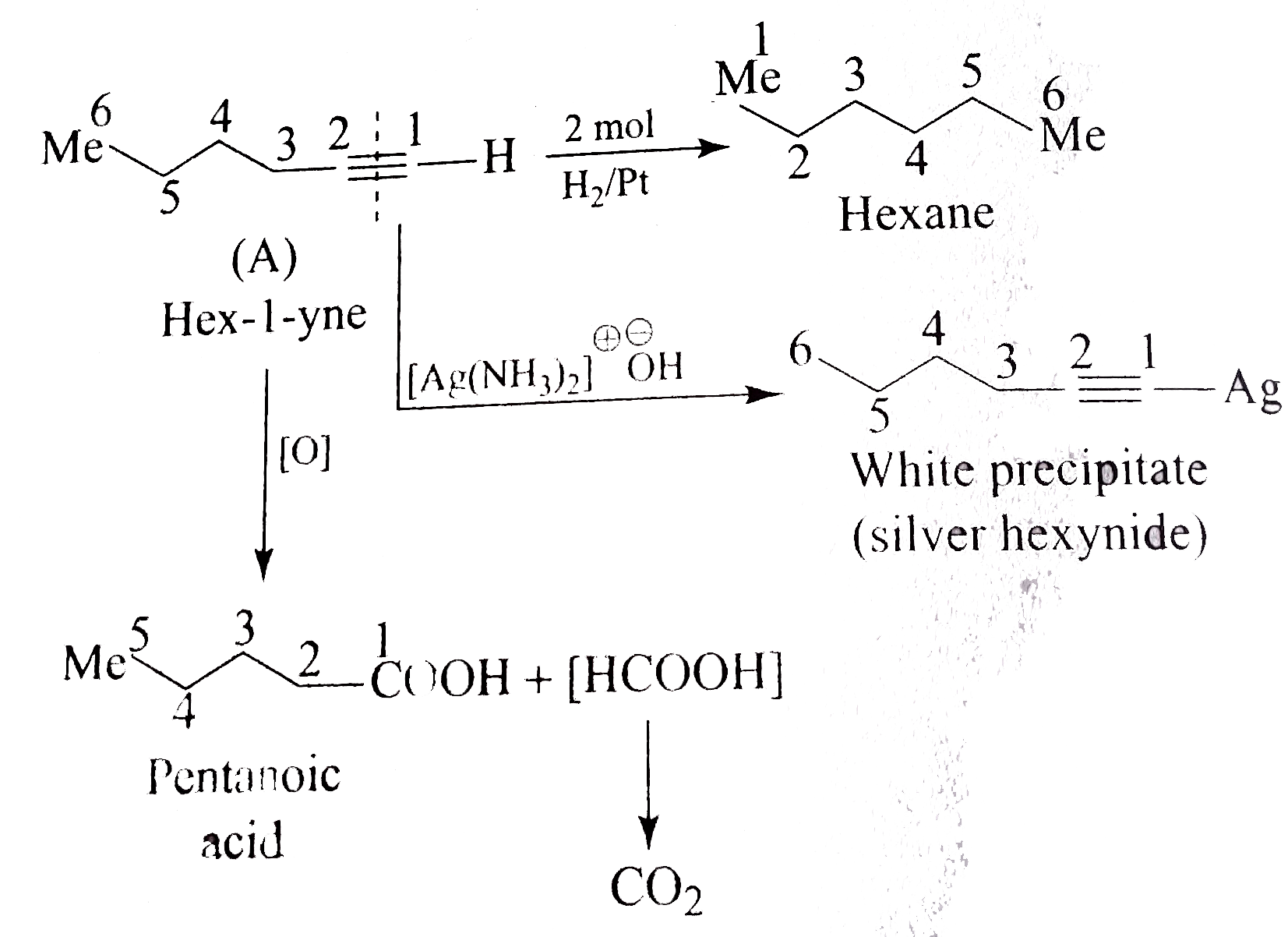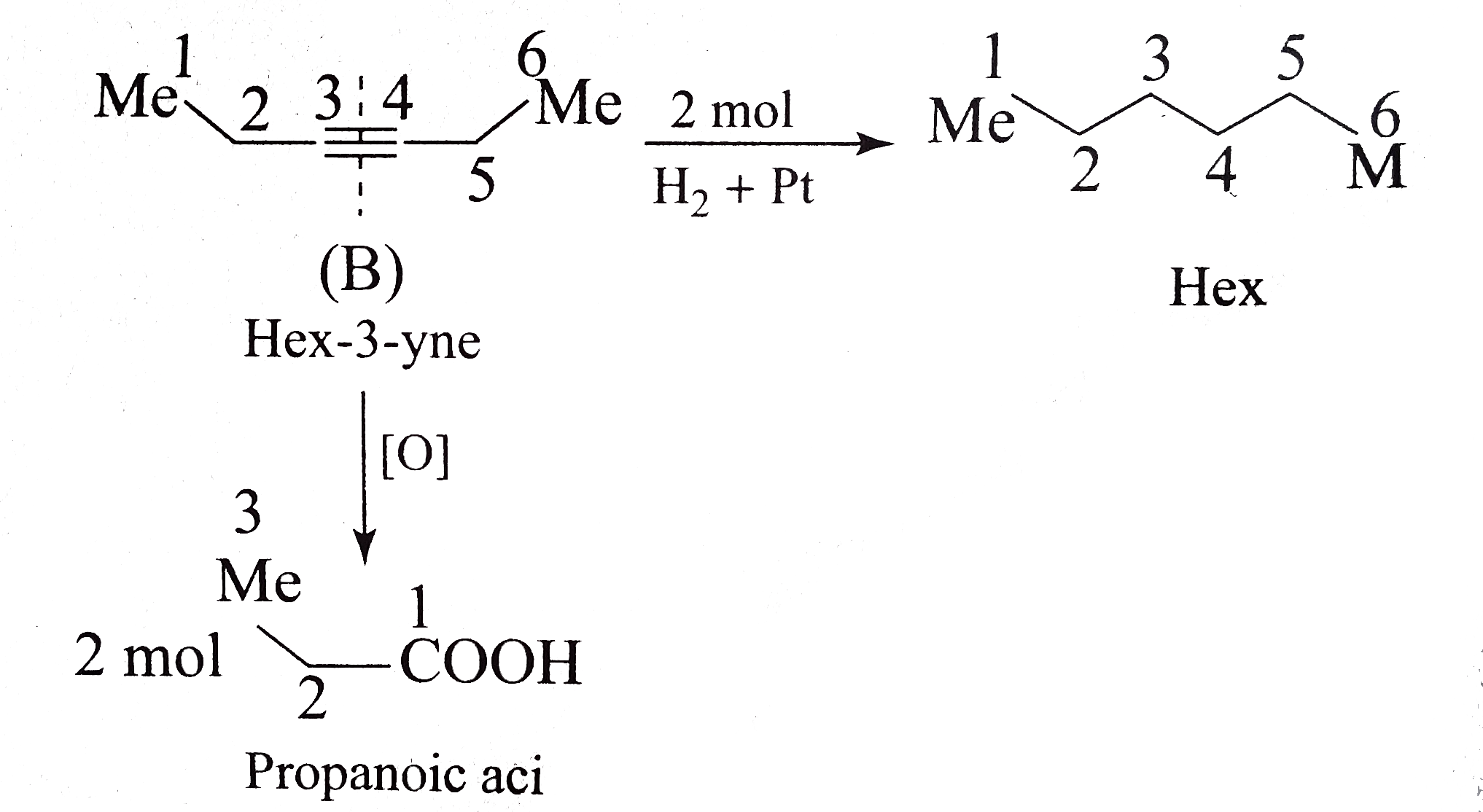Identify A, B, and C.
A, B, and C(C6H10)Br2/CCI2−−−−−−→All decolourisesBr2solution
Cold−−−−−−−→conc.H2SO4 All are soluble
(A)Ammoniacal−−−−−−→AgNO3 White precipitate
(AandB)excess−−−−−→ofH2/Pt Hexane
(C)1mol−−−→H2/PtD(C6H12)
(A)Hotalk.−−−−→KMnO4 Pent anoic acid only
(B)Hotalk.−−−−→KMnO4 Propanoic acid only
(C)Hotalk.−−−−→KMnO4 Adipic acid only
Video Solution
Text Solution
DU in A, B, and C=(2×6+2)−102=27∘.
Structure of (A):
(A) reacts with ammoniacal AgNO3 solution, which shows that it is a terminal alkyne with straight chain of six C atoms (because on hydrogenation it gives hexane). Therefore, (A) is hex-1-yne.

Structure of (B):
(B) does not react with [Ag(NH3)2]⊕ and hence it must be internal alkyne with straight chain of six C atoms (because on hydrogenation it gives hexane).
Location of triple bond is determined by oxidative cleavage. As it gives propanoic acid (3C-atom acid), it should be symmetrical internal alkyne.
Therefore, (B) is hex-3-yne.

Structure of (C):
It absorbs 1 mol of H2 and the product (D) (C6H12) after catalytic hydrogenation has 1 DU. So (D) must be a 6C-atom cyclic compound. Therefore, (C) is cyclohexene.

|
Updated on:21/07/2023
Topper's Solved these Questions
- BOOK - CENGAGE CHEMISTRY ENGLISHCHAPTER - ALKYNESEXERCISE - Exercises (Subjective Type)31videos
ALKYNES
- BOOK - CENGAGE CHEMISTRY ENGLISHCHAPTER - ALKYNESEXERCISE - Exercises (Linked Comprehension Type)51videos
ALKYNES
- BOOK - CENGAGE CHEMISTRY ENGLISHCHAPTER - ALKYNESEXERCISE - Exercises (Archives - Analytical and Desriptive Type)4videos
ALKYNES
- BOOK - CENGAGE CHEMISTRY ENGLISHCHAPTER - ALKENES AND ALKADIENESEXERCISE - Single correct Answer14videos
ALKENES AND ALKADIENES
- BOOK - CENGAGE CHEMISTRY ENGLISHCHAPTER - APPENDIX - INORGANIC VOLUME 1EXERCISE - chapter-7 Single correct answer1videos
APPENDIX - INORGANIC VOLUME 1
Similar Questions
Knowledge Check
- Question 1 - Select One
CH3−CH3∣C=CH−CH3∣C∣CH3−CH3NaIO4−−−−→KMnO4Products
The products are :ACH3−O∣∣C−OH(CH3)3C−COOHBCH3−O∣∣C−CH3,(CH3)3C−COOHCCH3−O∣∣C−CH3,(CH3)3C−CHODnone is correct - Question 2 - Select One
H3C−CH3∣C∣CH3−H+CCl4R2O2−−→hvProduct :
AH3C−CH3∣C∣CH3−ClBCHCl3CBoth (a) and (b)DNone of these - Question 3 - Select One
 Br2−−→CCl4(i)alc. KOH−−−−−−−→(ii)NaNH2(A)major, Product (A) is :AH2C=CH−CH=CH2BCH3−C≡C−CH3CCH3−CH2−C≡CHDCH3−CH=C=CH2
Br2−−→CCl4(i)alc. KOH−−−−−−−→(ii)NaNH2(A)major, Product (A) is :AH2C=CH−CH=CH2BCH3−C≡C−CH3CCH3−CH2−C≡CHDCH3−CH=C=CH2
CH3−CH3∣CH∣CH3KmnO4−−−−→(A)H+−−→Δ(B)HBr−−−→ROOR(C)
Product (C) in the above reactions is :View SolutionIdentify the compounds A, B and C:
H−C≡C−HH2O−−−−−−−−−−−→dil.H2SO4+HgSO4AH2−−→[Ni]B140∘C−−−−−−−→cons H2SO4CView SolutionC2H2Hg(OH)21%−−−−−−−−−−→H2SO4A[O]−−→B, B is :
View SolutionIn the reaction sequence
CH3−O∣∣C−H−HCN−−−→.ΘOH(A)H2O/⊕H−−−−→Δ Product is/are :View SolutionCH3−CH3∣C∣CH3−C∣BrH−CH3El mechanism−−−−−−−−−−→Δ(A)
Major product (A) isView Solution

